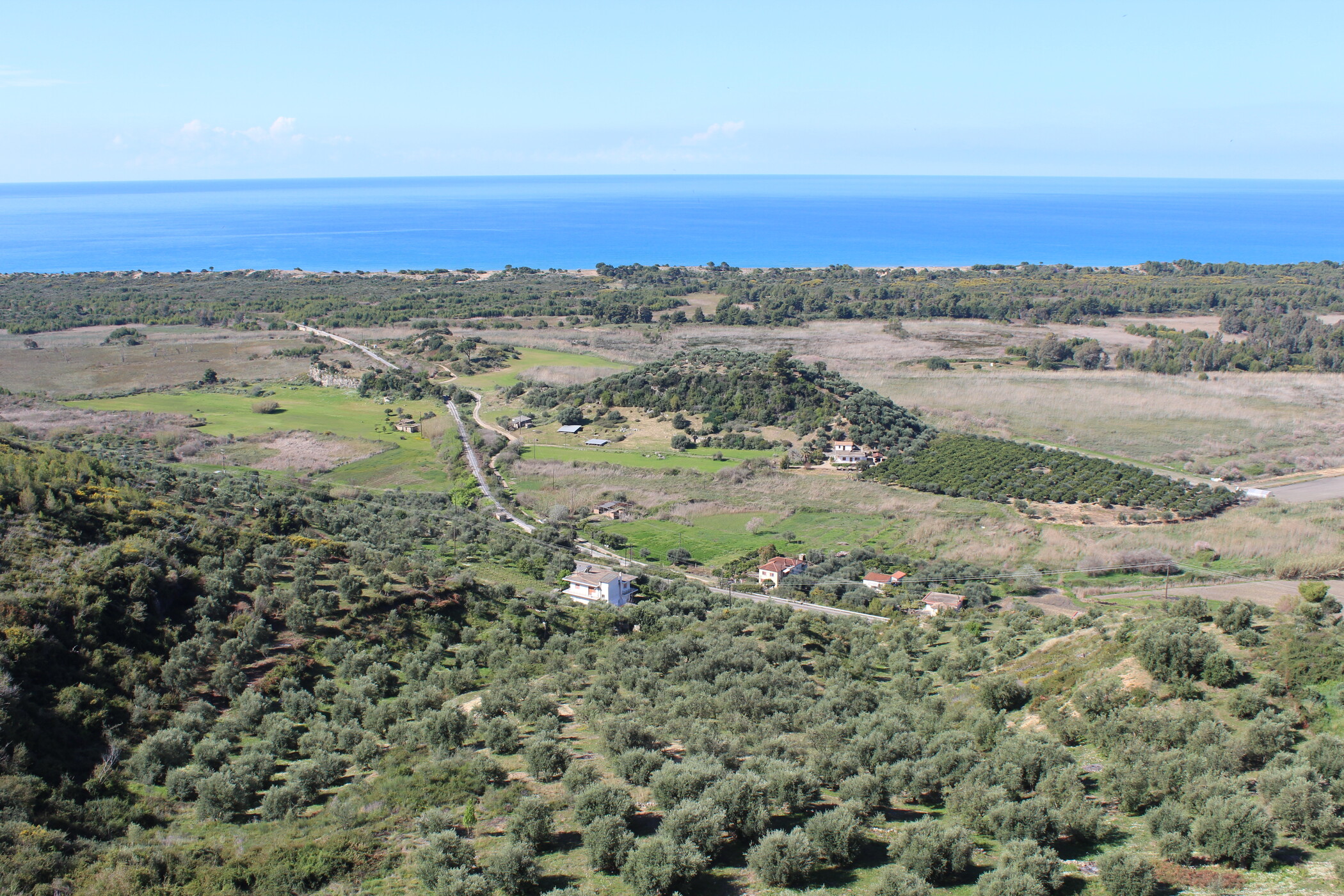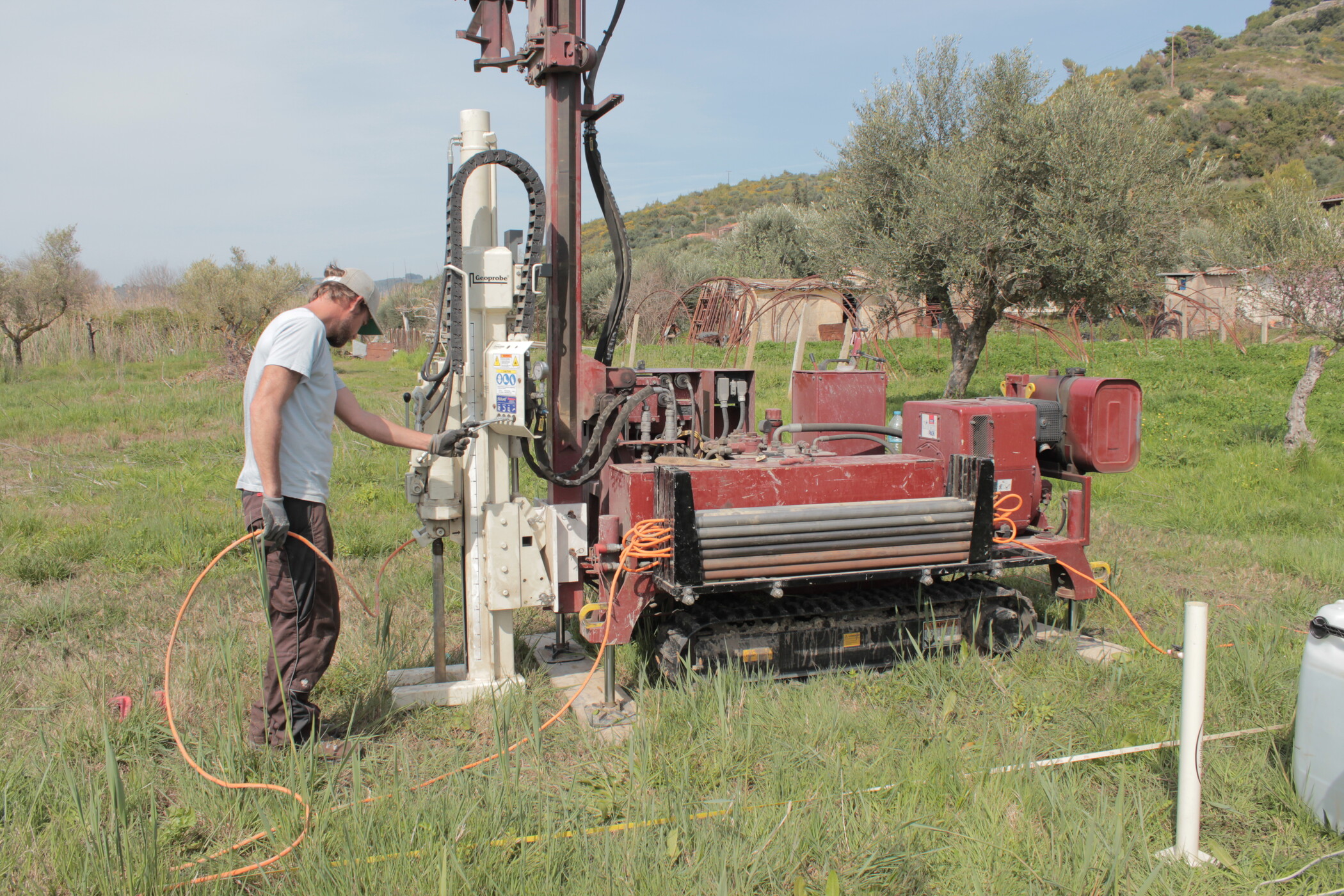Landscape-archaeological investigations at the 'Thermopylae' of the Peloponnese
Using geophysical and geoarchaeological methods, research has been carried out at a ›key spot‹ on the west coast of the Peloponnese lying between the lagoon of Kaiafa, the sulphur springs located there, and the fortress of Samikon. Kleidi is the site of a Bronze Age settlement in whose immediate vicinity a famous sanctuary of Poseidon, mentioned by Strabo, must have existed.
The site of Kleidi lies on the western summit of the Lapithos mountains that cut in an east-west direction through the region of Triphylia (modern Tryfilia) and extend as far as the western coast of the Peloponnese. Kleidi is located below the Classical-Hellenistic fortress at what is today Kato-Samikon. Three small hills are located in the coastal plain that covers the area of the former lagoon of Agoulinitsa. The lagoon was drained first in the late 1960s; earlier, it had extended as far as the group of hills. This fact explains the eponymous position of Kleidi that controlled the passage through the marshes until the 1960s: until the lagoon was drained, the only north-south connection on firm ground ran through here, parallel to the railway line, which was constructed in the early 20th century. The narrows at Kleidi are characterised as the ›Thermopylae of the Peloponnese‹ due to their strategic significance and to the warm sulphur springs that not only arise ca. 1.3 km to the south near Kaiafa, but also at a number of places around the group of hills, and which are still used today as therapeutic baths.
History of Research at Kleidi
The site of Kleidi has been known as a Bronze Age settlement site since the excavations of Wilhelm Dörpfeld in 1908. Here Dörpfeld brought to light primarily remains of so-called Cyclopean walls and traces of a Bronze Age settlement, yet these results were never published in detail. In 1954 Nikolas Yalouris undertook excavations to the north of the large hill and published a circular tomb, which became known as a tumulus and which contained burials from the entire Mycenaean period. At the beginning of the 1980s Eleni Papakonstantinou carried out extensive excavations on the plateau of the largest hill and on its eastern flank, where she was able to confirm the existence of a cemetery of the late Middle Bronze Age and the Late Bronze Age. Most recently, in 2007 Panagiotis Moutzouridis and Kostas Nikolentzos laid out excavation trenches on the southeastern part of the hill plateau, where they also encountered Middle and Late Bronze Age settlement traces. [For the evaluation of the Bronze Age pottery in the regional context, cf. Kakovatos und Triphylien im 2. Jahrtausend v. Chr.]
Current Research in Kleidi
In 2017, a Greek-Austrian cooperative project, under the direction of Erofili-Iris Kolia and Birgitta Eder, focused on the systematic surveying of the terrain of the group of hills of Kleidi with the goal of creating, for the first time, a plan of the group of hills with its morphology and preserved building remains.
The sanctuary of Poseidon near Samikon is also assumed to be located in the coastal plain of Kleidi-Samikon, which according to Strabo (8, 3, 16) constitutes one of the essential points of reference in the description of Triphylia with the specification of distances to the north (Alpheios) and to the south (Lepreon). The sacred area, whose character was shaped by a grove of wild olive trees, ought to have formed the centre of an amphictyony of the cities of Triphylia.
The project, therefore, aims to investigate the site that, in numerous ways, can be considered as a ›key site‹: although its general location – between the Kaiafa lagoon, the sulphur springs there and the fortification of Samikon – has been established in the environs of Kleidi, the sanctuary of Poseidon has not yet been discovered. The geography of the entire region must have altered considerably since antiquity, even though the reasons for this are not yet entirely clear. It is equally uncertain how the geographical situation was in ancient times, where the coastline was located, and where the anchorage mentioned by Strabo (8, 3, 17) was located. The reconstruction of the ancient landscape is just as significant for the Archaic, Classical and Hellenistic periods as for the Bronze Age, in order to understand the position of Kleidi within the regional topography of Triphylia, at a key site of the Peloponnesian west coast, in a diachronic perspective.
In this sense, the project is dedicated to g archaeological and geoarchaeological exploration of this micro region in order to reconstruct of the paleo-environment and the ancient landscape. The research is carried out as a collaboration between the Service of Antiquities of Elis (E.-I. Kolia), the ÖAI Athens (B. Eder), in cooperation with A. Vött and his team from the Geographical Institute of the University of Mainz.
Principal investigator
Cooperations
- E.-I. Kolia (Antikendienst Elis des Griechischen Ministeriums für Kultur und Sport)
- A. Vött und Team (Institut für Geographie der Universität Mainz)
Duration
Pilot project until 12/2021



